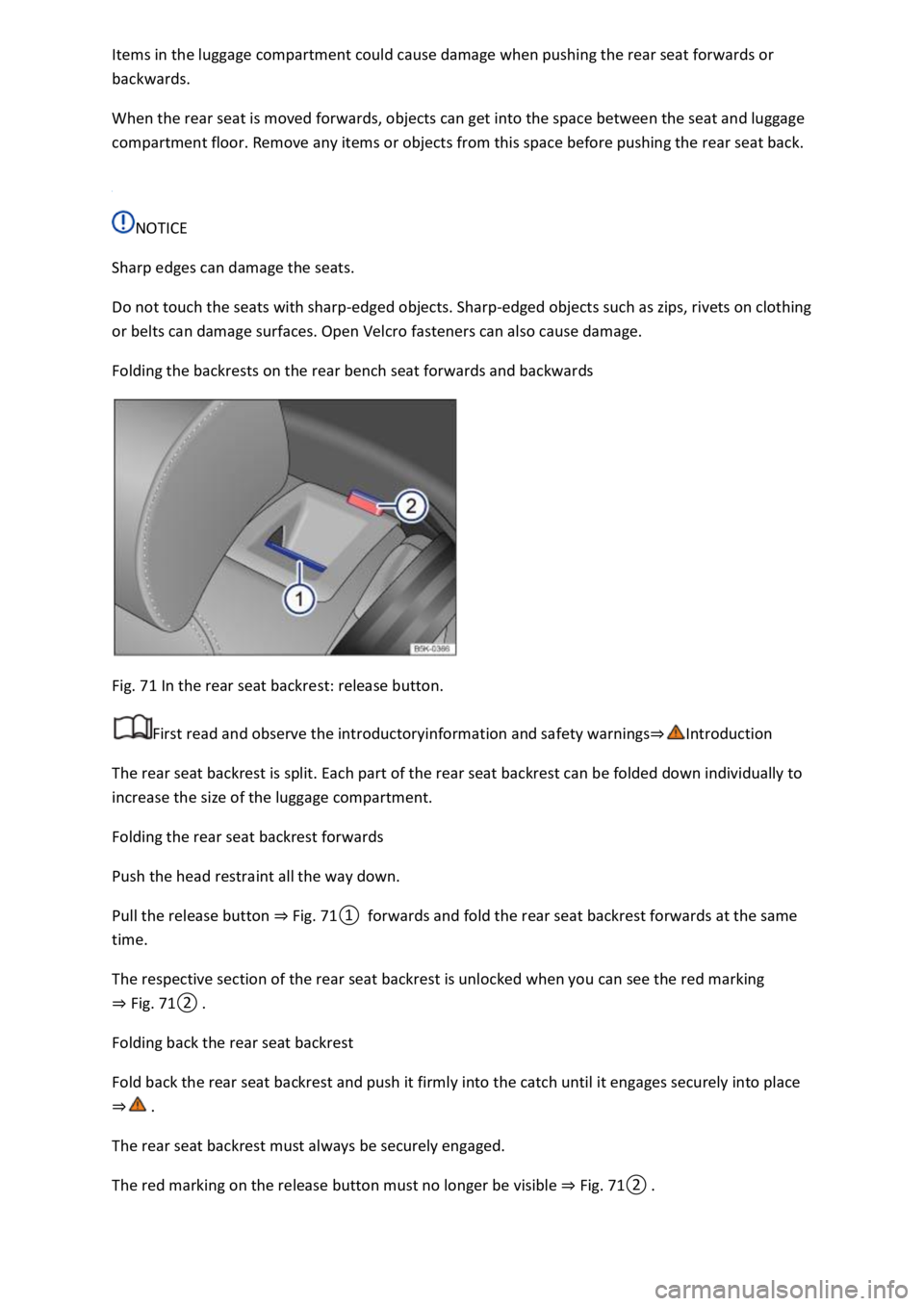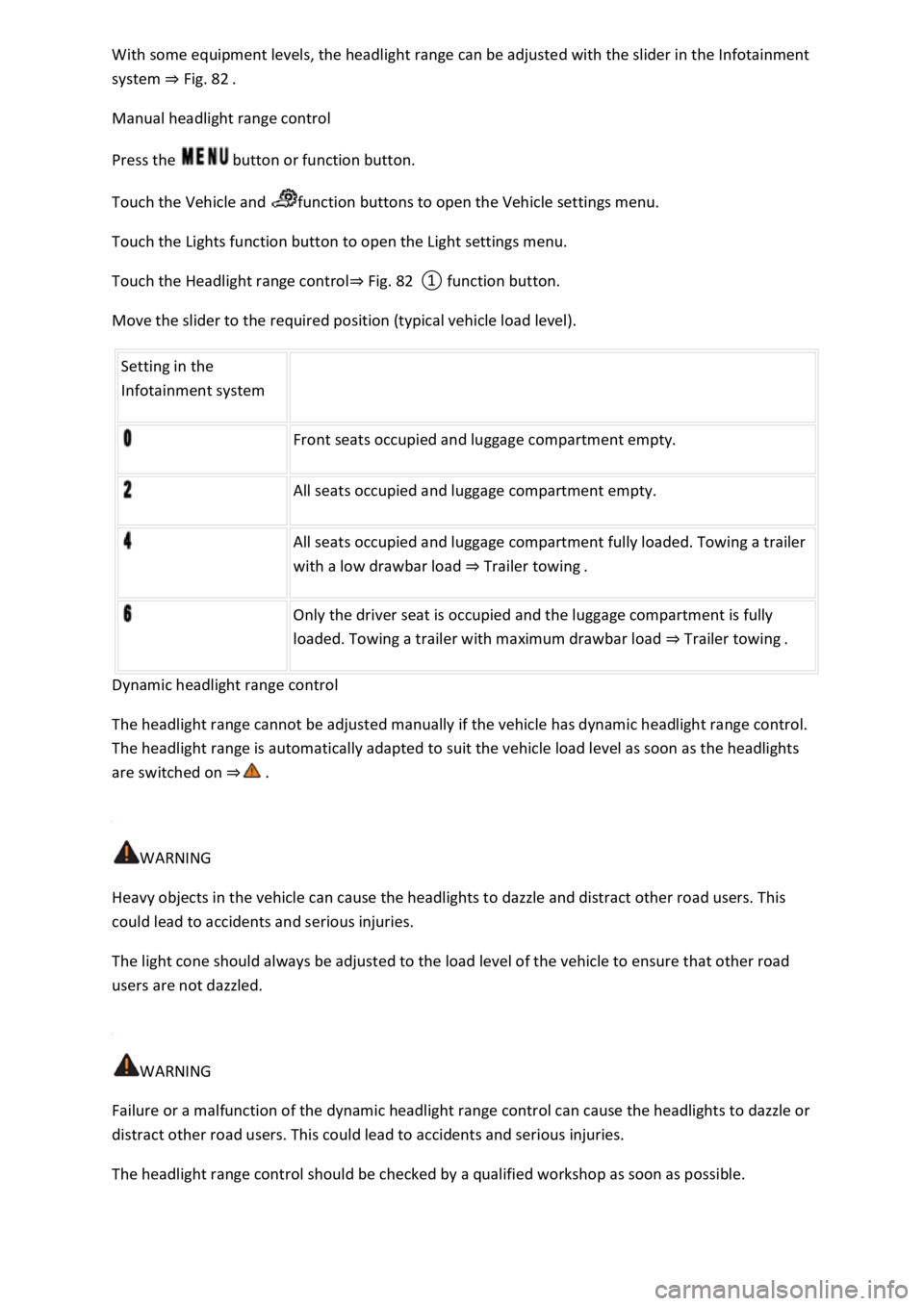2022 VOLKSWAGEN T-ROC seats
[x] Cancel search: seatsPage 123 of 502

backwards.
When the rear seat is moved forwards, objects can get into the space between the seat and luggage
compartment floor. Remove any items or objects from this space before pushing the rear seat back.
NOTICE
Sharp edges can damage the seats.
Do not touch the seats with sharp-edged objects. Sharp-edged objects such as zips, rivets on clothing
or belts can damage surfaces. Open Velcro fasteners can also cause damage.
Folding the backrests on the rear bench seat forwards and backwards
Fig. 71 In the rear seat backrest: release button.
First read and observe the introductoryinformation and safety warnings
The rear seat backrest is split. Each part of the rear seat backrest can be folded down individually to
increase the size of the luggage compartment.
Folding the rear seat backrest forwards
Push the head restraint all the way down.
Pull the release button Fig.
0forwards and fold the rear seat backrest forwards at the same
time.
The respective section of the rear seat backrest is unlocked when you can see the red marking
Fig.
0
Folding back the rear seat backrest
Fold back the rear seat backrest and push it firmly into the catch until it engages securely into place
The rear seat backrest must always be securely engaged.
The red marking on the release button must no longer be visible Fig.
0
Page 124 of 502

WARNING
Injuries can be caused if the rear seat backrests are folded forwards and backwards in an
uncontrolled way and without taking due care.
While folding the rear seat backrest forward, always make sure that no people or animals are in its
path.
Never fold the rear seat backrest forwards or backwards while the vehicle is in motion.
Ensure that the seat belt is not trapped or damaged when folding back the rear seat backrest.
Always keep hands, fingers, feet or other body parts away from the swivel area when folding the
rear seat backrest forwards and backwards.
Ensure that each rear seat backrest engages securely, otherwise the seat belts for the rear seats will
not offer maximum protection. This applies to the centre seat of the rear bench seat in particular. If
a seat is occupied and the corresponding rear seat backrest has not engaged securely into place, the
seat occupant and rear seat backrest may move forwards in the event of a sudden braking or driving
manoeuvre or during accidents.
Adults and children must not use seats if the corresponding backrest is folded forwards or is not
engaged securely into place.
NOTICE
Damage to the vehicle or to other objects could be caused if the rear bench seat backrest is folded
forwards and backwards in an uncontrolled way or without due care.
Before folding the rear seat backrests forwards, always adjust the front seats so that the rear head
restraints or rear seat cushions do impact the front seats.
Before folding down the rear seat backrest, always make sure that there are no objects located in its
path.
Head restraints
Introduction
This chapter contains information on the followingsubjects:
Adjusting the head restraints
Removing and installing head restraints
The following section describes the options for adjusting and removing the head restraints. Always
ensure that you adjust the correct sitting position Sitting position
Every seat is fitted with a head restraint. The centre head restraint at the rear is designed solely for
use with the centre rear bench seat. Therefore you should not install this head restraint in any of the
other positions.
Page 139 of 502

system Fig. 82
Manual headlight range control
Press the button or function button.
Touch the Vehicle and function buttons to open the Vehicle settings menu.
Touch the Lights function button to open the Light settings menu.
Touch the Headlight range controlFig. 82
Move the slider to the required position (typical vehicle load level).
Setting in the
Infotainment system
Front seats occupied and luggage compartment empty.
All seats occupied and luggage compartment empty.
All seats occupied and luggage compartment fully loaded. Towing a trailer
with a low drawbar load Trailer towing.
Only the driver seat is occupied and the luggage compartment is fully
loaded. Towing a trailer with maximum drawbar load Trailer towing.
Dynamic headlight range control
The headlight range cannot be adjusted manually if the vehicle has dynamic headlight range control.
The headlight range is automatically adapted to suit the vehicle load level as soon as the headlights
are switched on
WARNING
Heavy objects in the vehicle can cause the headlights to dazzle and distract other road users. This
could lead to accidents and serious injuries.
The light cone should always be adjusted to the load level of the vehicle to ensure that other road
users are not dazzled.
WARNING
Failure or a malfunction of the dynamic headlight range control can cause the headlights to dazzle or
distract other road users. This could lead to accidents and serious injuries.
The headlight range control should be checked by a qualified workshop as soon as possible.
Page 172 of 502

file Driving profile selection and 4MOTION Active Control
Avoid driving at full throttle
Never drive the vehicle at its top speed. The drag coefficient increases at excessively high speeds.
This in turn increases the force needed to move the vehicle.
Reduce idling
Pull away immediately with low engine speeds. If you are stopped for a long period, do not allow the
engine to idle but switch it off, e.g. when in a traffic jam or at a railway crossing.
In vehicles with an activated start/stop system, the engine can switch off automatically when the
vehicle is stopping and when the vehicle is stationary Start/stop system
Refuel moderately
A full fuel tank increases the weight of the vehicle. A fuel tank that is half or two thirds of the way
full is sufficient for journeys in urban traffic in particular.
Avoid short journeys
A cold engine has very high fuel consumption. The optimum operating temperature is reached only
after driving a few kilometres. The fuel consumption is above average at very low ambient
temperatures, e.g. in winter Fig. 97
Carry out regular maintenance
Regular maintenance is an essential prerequisite for economical driving and increases the service life
of the vehicle.
Observe the tyre pressures
Low tyre pressures does not just mean greater wear, but also increase the rolling resistance of the
tyres and thus the fuel consumption. Use optimised rolling resistance tyres.
Adjust the tyre pressure according to the load. Observe the information on the tyre pressure sticker
Useful information about wheels and tyres
Tyre Pressure Loss Indicator or Tyre Pressure Monitoring System Tyre monitoring system
Use low viscosity engine oils
Fully synthetic engine oils with a low viscosity decrease frictional resistance in the engine and are
distributed better and more quickly, especially during cold starts.
Do not drive with unnecessary loads in the vehicle
You can reduce fuel consumption by clearing out the luggage compartment before setting off, for
example by removing empty drink crates or unused child seats.
To keep the vehicle's air resistance as low as possible, remove any add-on parts and equipment such
as ski racks, bicycle racks and roof carriers once you have finished using them.
Save electrical energy
Page 445 of 502

Clean with a soft, lint-free cloth and plenty of water. Treat with Volkswagen Genuine rubber care
agent (- 000 096 310 -) on a regular basis.
Seat belts:
Carefully pull the seat belt right out and leave it out
Clean the seat belt with a mild soap solution. Leave the belt fabric to dry completely and then allow
it to roll up.
Wooden trims:
Clean with a soft cloth and some mild soap solution1).
Cleaning upholstery fabrics
If clothing that is not sufficiently colour-fast, e.g. denim, leaves stains on the seat cushion, this is not
a defect in the cover fabric. The seat padding may contain components for the airbag system and
electrical connections. Seat padding that is damaged, incorrectly cleaned or treated, or that
becomes wet, may cause damage to the vehicle electrical system or cause a fault in the airbag
system
Depending on the equipment, seat cushions with seat heating feature electrical components and
connectors that may be damaged in the event of incorrect cleaning or treatment
result in damage to other parts of the vehicle electrics.
-pressure cleaners, steam cleaners or cold spray.
n the seat heating to dry the seats.
WARNING
Incorrect cleaning can cause damage to the seat belts, the belt anchorages and the belt retractor.
belt buckles against the ingress of liquids and foreign bodies.
NOTICE
Page 449 of 502

specifications
Modifications and repairs to the front bumper, doors, front seats, headliner or the bodywork should
be carried out only by a qualified workshop. Airbag system components and sensors might be fitted
on these vehicle components.
If you work on the airbag system or remove and install parts of the system when performing other
repair work, parts of the airbag system may be damaged. The consequence may be that, in the event
of an accident, the airbag inflates incorrectly or does not inflate at all.
Regulations must be observed to ensure that the effectiveness of the airbags is not reduced and that
removed parts do not cause any injuries or environmental pollution. Qualified workshops are
familiar with these regulations.
Any modifications to the vehicle's suspension could prevent the airbag system from working
properly during a collision. For example, using wheel rim/tyre combinations that have not been
approved by Volkswagen, lowering the suspension or making modifications to the suspension rate
including work on the springs, struts and shock absorbers etc., could change the forces that are
measured by the airbag sensors and sent to the electronic control unit. Some changes to the
suspension could cause the forces measured by the sensors to increase, for example. This can lead
to the airbag system being triggered in collision scenarios where it normally would not be triggered if
modifications to the suspension had not been made. Other modifications can cause the forces
measured by the sensors to decrease, therefore preventing the airbag system from being triggered
when it should have been.
WARNING
Incorrect repairs and modifications can cause malfunctions and damage to the vehicle and impair
the effectiveness of the airbag system. This can result in accidents and serious or even fatal injuries.
en taken from end-of-life
vehicles in your vehicle.
WARNING
Modifications to the vehicle's suspension, including the use of unsuitable tyre/rim combinations, can
cause the airbag system to function differently and increase the risk of serious or fatal injuries in the
event of an accident.
the original factory-fitted components.
en.
Mobile reception in the vehicle
Page 459 of 502

vehicle production, with the basic requirements and other relevant laws and regulations, including
FCC Part 15.19, FCC Part 15.21 and RSS-Gen Issue 1:
Radio-based equipment
luding City Emergency Braking System.
Electrical equipment
-volt socket.
Recycling and scrapping end-of-life vehicles
Recycling end-of-life vehicles
Volkswagen has already made provision for you to recycle your vehicle in an environmentally
responsible manner. The extensive recycling systems operating in many European countries will take
back your vehicle at the end of its useful life. Once the vehicle has been recycled, a certificate of
destruction will be issued to show that the vehicle has been disposed of correctly.
Return of end-of-life vehicles is free of charge, provided that national legislation is complied with.
Further information on return and recycling of end-of-life vehicles is available from a Volkswagen
dealership.
Scrapping
The relevant safety requirements must be observed when the vehicle or its individual components,
e.g. from the airbag system and belt tensioners, are scrapped. Qualified workshops are familiar with
these regulations.
Information about vehicles with N1 approval (light commercial vehicle)
Please observe the following for vehicles used to transport goods with a maximum permitted weight
of up to 3.5 t (N1 approval in Europe):
Variants and number of seats
There are various types of N1 vehicles based on a Volkswagen passenger car. The number of seats
may be restricted to two or four.
Page 460 of 502

ering in the rear of the vehicle interior because there is
no rear bench seat
Vehicles with four seats: the centre seat on the rear bench seat cannot be used
Transporting children safely
As with vehicles with passenger car approval (M1), approved child restraint systems can be used on
the seats Safe transport of children
Towing a trailer
If the vehicle is approved for towing a trailer, observe any local regulations for driving with a trailer
and using a towing bracket.
If the vehicle exceeds the gross vehicle weight rating or the rear axle load, do not exceed 80 km/h
when towing a trailer. This also applies to countries where higher speeds are permitted. Keep to
country-specific speed limits which may be lower for vehicles with trailers than for vehicles without
trailers.
The vehicle documents contain details of permitted excess loads. If no excess loads are shown, the
vehicle can be driven at 100 km/h, taking account of the laws which apply in different countries.
Technical data
Please refer to the vehicle documentation for technical data.
WARNING
Risk of injury and electric shock from exposed cables.
vehicle are covered up when using the vehicle.
WARNING
Risk of serious injuries due to transporting passengers incorrectly.
ms such as seat
belts and head restraints.
WARNING
Risk of serious and fatal injuries.